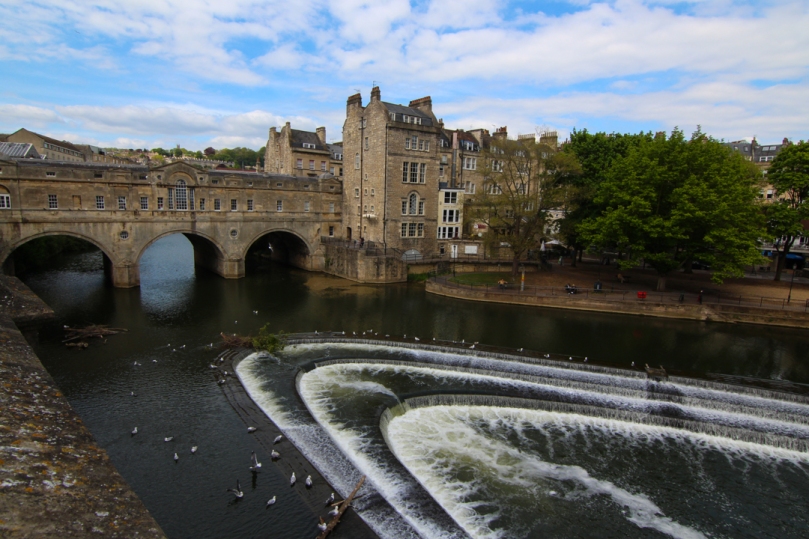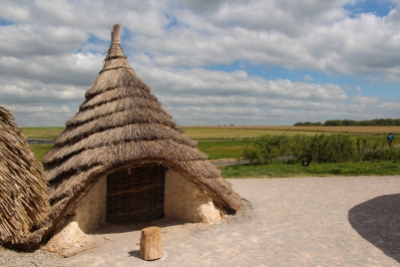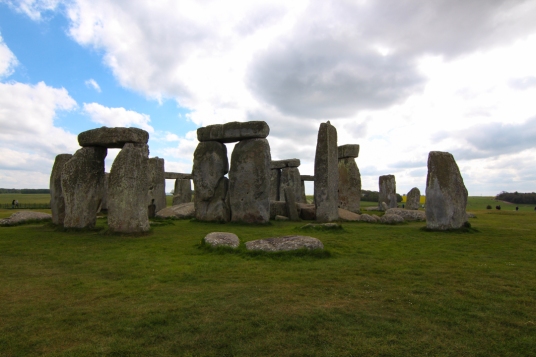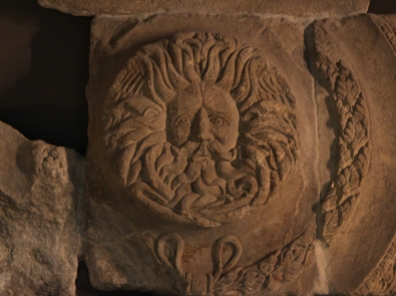“Have you been to Stonehenge yet?” –the question my brother kept asking me every time we got to talk since my moving to London. “No Alex, I haven’t yet”
That answer changed on the 5th of May when we finally went to Stonehenge!
Since we also wanted to visit Bath, we thought the easiest way to get there would be to book a one day tour for these two locations. There were tours that also included a 3rd location in the trip but I really don’t recommend it. I felt like we didn’t have enough time for two locations in one day, I can’t imagine how it would have been like with three.
We left London at 8:30 from Gloucester Road and I believe it took us a little under 2 hours to get to our first destination – Stonehenge.
The parking at Stonehenge is not next to the monument, it’s around 20 minutes by foot from it. You can get to the actual monument either by bus, provided by the English Heritage (and the buses are frequent so you don’t have to wait long) or simply walk there. Since we had only 2 hours to visit the place we took the bus and we got there aaaaand there they were, the most famous bunch of stones in the world! We couldn’t get into the circle as it was surrounded by ropes but it was still an amazing feeling to be there. I could feel the mysticism in the air…and I was definitely feeling the wind…the wind literally blew us away.

Built in the Neolithic period, in 3000 BC, the first Stonehenge was a simple circular enclosure defined by a ditch, an inner bank and a small outer bank. This type of earthwork was not very different from other enclosures dating from that period but
Stonehenge became unique when the actual stones were brought to the site, in 2500 BC.
Below are replicas of different types of Neolithic houses in which the builders of the monument might have lived.
There are 2 circles that define Stonehenge: the sarsen circle and the bluestone circle.
The sarsen circle is the outermost setting and was intended to have 30 upright large sarsen stones capping with 30 horizontal lintels to form a complete and perfect circle. A lot of pieces are missing from the structure, especially on the south-west side, and there are only 17 upright sarsens and 6 lintels in place today. The north-eastern side of Stonehenge is more complete and resembles the original site.

The sarsen stones are the largest stones you’ll see there, and they are a type of very hard sandstone which can be found 30 Km away from Stonehenge. They weight around 35 tonnes, so the people that built this place must have put quite some effort into moving those around.
But not as much effort as into getting the bluestones there!
The bluestone, which form the inner circle, are smaller than the sarsen stones, weighting only 3 tonnes, but they originate from the Preseli Hills of Wales, which is 240Km away from Stonehenge! Initially there were 80 bluestones on site and the archeologists are still unsure of how they were transported 4500 years ago.
Another big mystery is why the actual site was built. It’s clear that a lot of effort was put into building Stonehenge and it’s believed to have been a place for celebration, for ceremony and a burial ground.
Also, folk tales talk about the healing powers of the bluestones, which might explain the effort put into bringing those stones all they way from Preseli Hills in Wales.
One of the cool things about the monument is how carefully it was aligned in order to mark the changing of the seasons. At midwinter, the sun sets in the south-west part of the sky and at midsummer, the sun rises in the north-east and Stonehenge is aligned with both solstices.
Cool fact:
For summer solstice they do allow access to the circle and the entrance to the site is free (the parking isn’t though as I’ve just read)! You would be there with over 10000 people as it’s like a pagan celebration, but if you’re into that kind of thing it’s something to take into consideration.
I’m actually writing this on summer solstice day (21st of June 2017) and last night my boyfriend and I watched a live stream from Stonehenge and it looked amazing to be honest. We promised ourselves we will go there next year!

So now we can call ourselves proper tourists as we’ve been to Stonehenge and my brother has stopped asking me if I’ve been to Stonehenge but asks me if I’ve been to Hastings yet.
And then we were off to Bath!
The drive to Bath took around one hour and it was quite nice as we could enjoy some amazing views of the English countryside: so much greenery, lovely cottages and fields and fields of rapeseed which looked incredible.
Bath is a World Heritage Site famous for its Roman-built baths and it’s simply…beautiful.
The city is also famous for its Gregorian architecture like the Royal Crescent, a row of 30 terraced houses laid out to form a crescent shape and the Circus, which we also got to see.

Jane Austen lived there for some time and there is a small museum called the ‘Jane Austen Centre’ that can be visited.
A fine example of Perpendicular Gothic Architecture, The Bath Abbey is located right next to the Roman Baths and it’s history spans over 1000 years. Initially an Anglo-Saxon monastery, it was pulled down by the Normans to build a Norman cathedral in 1090 and the building we see today was started in 1499 and finished in the 19th Century.
The Roman Baths is the most popular place to visit in Bath. Luckily we got to see this place even if we were a bit in a hurry as we had around one hour before the bus was due to leave. I’m glad we went in as it’s something one needs to see if ever in Bath.
According to their official guidebook, the Roman Baths in Bath is “the best preserved ancient baths and temple complex in northern Europe” and it’s the only thermal springs in the UK.
We got to see architectural fragments of the Temple of Sulis Minerva, the Goddess of the thermal spring, and the actual bath house that’s been around for 2000 years. In their museum they have lots of objects that used to be thrown in the sacred spring, but the coolest pieces are the actual remains of the temple and my favourite, the gilt bronze head of the goddess Minerva. This statue was once unavailable to the public, only the priests attending the temple could see it but nowadays we can, so that’s pretty cool.
Before we decided to actually go inside the Roman Baths we also got to see and go across Pulteney Bridge. The bridge crosses the river Avon and it’s quite interesting as it has shops built across its full span, on both sides. I read somewhere that there are only 4 bridges like this in the world but I wouldn’t bet my life on it.

The three hours and a half we spent in Bath were definitely not enough and we need to go back one day.























